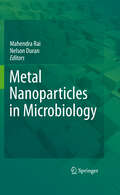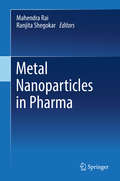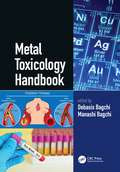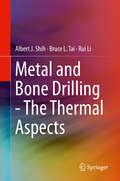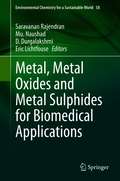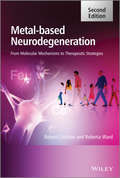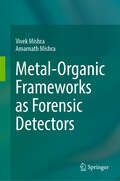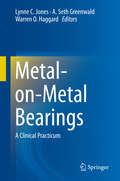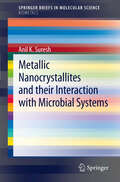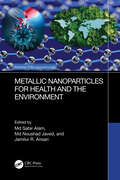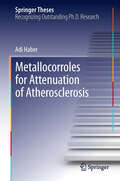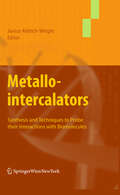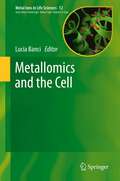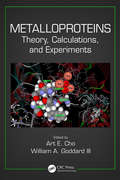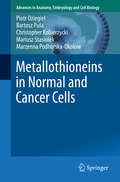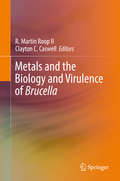- Table View
- List View
Metal Nanoparticles in Microbiology
by Mahendra Rai Nelson DuranFollowing an introduction to biogenic metal nanoparticles, this book presents how they can be biosynthesized using bacteria, fungi and yeast, as well as their potential applications in biomedicine. It is shown that the synthesis of nanoparticles using microbes is eco-friendly and results in reproducible metal nanoparticles of well-defined sizes, shapes and structures. This biotechnological approach based on the process of biomineralization exploits the effectiveness and flexibility of biological systems. Chapters include practical protocols for microbial synthesis of nanoparticles and microbial screening methods for isolating a specific nanoparticle producer as well as reviews on process optimization, industrial scale production, biomolecule-nanoparticle interactions, magnetosomes, silver nanoparticles and their numerous applications in medicine, and the application of gold nanoparticles in developing sensitive biosensors.
Metal Nanoparticles in Pharma
by Mahendra Rai Ranjita ShegokarCompletely dedicated to the biomedical applications of metal nanoparticles, this book covers the different toxicity problems found in healthcare situations and also provides comprehensive info on the use of metal nanoparticles in treating various diseases. Metal Nanoparticles in Pharma is the first edited volume to set up the discussion for a clinical setting and to target a pharmaceutical audience of academic and industry-based researchers.
Metal Toxicology Handbook
by Debasis Bagchi and Manashi BagchiHeavy metals and metalloids, singly or in combination, induce toxic manifestations either through acute or chronic pathology. In particular, long-term chronic exposure to diverse heavy metals and metalloids to humans and animals can lead to numerous physical, muscular, neurological, nephrological, and diverse degenerative diseases and dysfunctions, including multiple sclerosis, muscular dystrophy, Parkinson’s and Alzheimer’s diseases, cardiovascular disorders, and several others. Recognized heavy metals such as lead, mercury, arsenic, cadmium, thallium, and hexavalent chromium are known for enormous toxicity. The immediate vital signs of acute heavy metal exposure include nausea, vomiting, diarrhea, and acute abdominal pain. Mercury has been identified as the most toxic heavy metal, and mercury poisoning is known as acrodynia or pink disease. Similarly, lead, another toxic heavy metal, was at one time an integral part of painting. Metal Toxicology Handbook further explains and discusses the varying attributes of metals, discussing toxicity, safety, and proper human utilization of metals. Beginning with a broad overview of metals, metalloids, redox biology, and neurodegeneration and going further into the roles, benefits, and toxicity of metals with each section, the text contains 28 chapters from eminent researchers and scientists in their respective fields and is a must-have for anyone researching the potential toxicity in metals. Key Features Discusses the pathology of metal toxicity Highlights the benefits of metals Explains the mechanism and salient features of restoring metabolic homeostasis Highlights dose-dependent beneficial and adverse effects of vanadium safety and toxicity The initial introductory section provides a broad overview of metals, metalloids, redox biology, and neurodegeneration. The second section discusses the pathology of metal toxicity in two chapters, while the third section highlights the mechanism and salient features of restoring metabolic homeostasis in two chapters. The fourth section demonstrates the aspect of radionuclides toxicity. In a change of pace, the fifth section discusses the benefits of metals in four chapters. The sixth section, titled "Toxic Manifestations by Diverse Heavy Metals and Metalloids," provides fourteen chapters that discuss the toxicological mechanism and manifestation of individual metals. The editors have crafted a commentary titled "A Treatise on Metal Toxicity" and summarized a vivid scenario of metal toxicity and its consequences.
Metal and Bone Drilling - The Thermal Aspects
by Rui Li Albert J. Shih Bruce L. TaiThis book introduces state-of-the-art experimental and numerical methods and examples for evaluating the drilling performance of engineering and biological materials, particularly in thermal aspects. The authors use a common pathway to present the technological and analytical methods for both industry (metal) drilling and orthopaedic surgery (bone) drilling research, making this book a resource for both industrial and clinical readers who wish to understand the evolution of technologies, techniques and challenges in drilling. The authors also focus on advanced engineering materials, such as titanium alloys and high-strength cast irons, which have broad applications in the automotive, aerospace, medical device and sports industries. This book is a must-read for a broad audience, including engineering students in upper-level undergraduate and graduate courses that involve machining processes; for surgery residents, fellows, and practicing surgeons; and for engineers in the medical device industry who develop new bone cutting tools.Bridges the knowledge on drilling from the manufacturing industry to healthcare;Covers the experimental and modeling aspects of drilling thermal analysis;Includes experimental studies that contain parameters and data that emulate practical production and clinical drilling.
Metal, Metal Oxides and Metal Sulphides for Biomedical Applications (Environmental Chemistry for a Sustainable World #58)
by Eric Lichtfouse Mu. Naushad Saravanan Rajendran D. DurgalakshmiThis book presents recent advances in inorganic nanomaterials for healthcare, with focus on the synthesis, medical applications and toxicity of metals, metal oxides and metal sulfides. Major applications include diagnosis, bioimaging, biosensing, healing and therapy in cancer, diabetes, cardiovascular diseases, obesity, metabolic syndrome, dentistry and antimicrobials.
Metal-Based Neurodegeneration
by Robert Crichton Roberta WardNeurodegenerative diseases of the human brain appear in various forms, resulting in disorders of movement and coordination, cognitive deterioration and psychiatric disturbances. Many of the key factors leading to neurodegenerative diseases are similar, including the dysfunction of metal ion homeostasis, redox-active metal ions generating oxidative stress, and intracellular inclusion bodies.Metal-based Neurodegeneration presents a detailed survey of the molecular origins of neurodegenerative diseases. Each chapter is dedicated to a specific disease, presenting the latest scientific findings, including details of their biochemical actors (proteins or peptides), their normal and pathological conformations, and a description of the diseases characteristics, with an emphasis on the role of metal-induced oxidative stress, which can result in the production of intracellular aggregates of target proteins and peptides. Topics covered include:Brain function, physiology and the blood-brain barrierImmune system and neuroinflammationAging and mild cognitive impairment, MCIParkinson's DiseaseAlzheimer's DiseaseCreutzfelt-Jakob and related prion diseasesAlcoholic Brain DamageTherapeutic strategies to combat the onset and progression of neurological diseasesThis extensively updated, full colour, second edition of Metal-based Neurodegeneration is an essential text for research scientists and clinicians working in gerontology, neuropathology, neurochemistry, and metalloprotein mechanisms.
Metal-Organic Frameworks as Forensic Detectors
by Vivek Mishra Amarnath MishraThis book illustrates the application of Metal-Organic Frameworks (MOFs) based detectors and scientific methods in the Forensic sciences. The introductory chapter provides metal-organic frameworks as materials for applications in sensors and reviews their photochemical and electrochemical properties. The subsequent chapter probes the interaction between Metal-Organic Frameworks and forensic samples. Further, the chapters discuss the applications of the metal-organic framework for the detection of fingerprint latent, lip-print, palm-print, pesticides, and antibiotics in forensic samples. Further, the chapters review the use of metal-organic frameworks for the detection of drugs of abuse, explosives, hazardous chemicals, and gunshots residual. Towards the end, the chapter reviews the advantages and disadvantages of MOFs during forensic sample detection and current challenges and prospects. This book provides useful information on applications of metal-organic Frameworks for forensic scientists and legal professionals.
Metal-on-Metal Bearings
by Lynne C. Jones A. Seth Greenwald Warren O. HaggardThis book addresses the background and significance of the factors potentially influencing the clinical and biological outcomes of metal-on-metal hip implants. Metal-on-metal bearings were introduced and evaluated as an alternative to other bearing couples, particularly metal-on-polyethylene, due to their enhanced wear resistance as determined in laboratory testing. Initially, reports of short-term clinical outcomes were favorable and an increasing number of metal-on-metal prostheses were implanted. Subsequently, isolated case findings describing adverse tissue responses around the articulation became the harbinger of an increasing number of reports describing pseudotumors and other significant lymphocytic-based responses associated with metal-on-metal prostheses. Questions have been raised as to whether this is an implant, design, or patient-specific response. The reasons why some patients have a negative biological response and pathology while others do not remain to be determined, but tens of thousands of patients in the US, the UK, and around the world are considered to be at risk. Leading researchers and clinicians describe the issues related to the nature of the biological and pathological responses and the protocols that should be followed to determine if an adverse response is occurring. This book is essential reading for researchers, engineers, and orthopaedic surgeons who are involved in the design, evaluation, and implantation of metal-on-metal prostheses.
Metallic Nanocrystallites and their Interaction with Microbial Systems
by Anil K. SureshAlthough interactions between nanoparticles and microorganisms in the environment are unavoidable and commonplace, it is still not clear what potential effects they may have. Metallic Nanocrystallites and their Interface with Microbial Systems not only illustrates how microbes and these particular nanoparticles interact but also it describes the consequences of these interactions. This brief discusses the impact of gold, silver, zinc oxide, and cerium oxide nanoparticles on the growth and viability of both Gram-negative and Gram-positive bacterium. Moreover, it analyses the relationship between bacterial growth inhibition, reactive oxygen species generation, the regulation of transcriptional stress genomes, and the toxicity of these materials. Finally, it reviews the specific metallic nanomaterials and highlights their modes of synthesis, reactivity at surfaces, and the importance of assay procedures in determining their toxicity levels. Various microscopy techniques used to determine their mechanisms of action are also presented. Metallic Nanocrystallites and their Interface with Microbial Systems will be a valuable source to the scientific and industrial community as well as to students and researchers in microbiology, biotechnology, nanotechnology, toxicology, materials science, biomedical engineering, cell and molecular biology.
Metallic Nanoparticles for Health and the Environment (Advances in Bionanotechnology)
by Md Sabir Alam Md Noushad Javed Jamilur R. AnsariMetallic Nanoparticles for Health and the Environment covers different routes of synthesis for metallic nanoparticles and their process variables. Both the functions and roles of these particles as a drug delivery system and diagnostic agent and other potential theranostic purposes against metabolic disorders, photocatalysis applications, as well as wastewater treatments, are discussed. The book compares the different properties of bulk metallic forms and their nanoparticulated forms. It discusses the mechanisms and impacts of different process variables in different synthesis routes, as well as emerging trends in clinics and so forth. Features: Covers different routes of synthesis to create metallic nanoparticles (MNPs) of different characteristics with reference to bulk forms of metals. Describes formulation parameters that have a significant effect on these MNPs including dimensions, morphology, mechanism, surface properties, and other characteristics. Discusses different roles and performances of MNPs in photothermal therapy, metabolic disorders, mechanisms in bacterial, fungal, and viral infections, and inflammatory pathways. Reviews the potential and emerging roles of different MNPs with site target delivery applications and genetic manipulation purposes. Examines the advantages and challenges of these MNPs against remediation of pollutants and toxicants, owing to their superior surface catalytic activities. This book is aimed at researchers and professionals in nanomaterials, pharmaceuticals, and drug delivery.
Metallocorroles for Attenuation of Atherosclerosis
by Adi HaberAdi Haber's thesis summarises the use of a new entity, the corrole, to combat one of the major cardiovascular diseases, atherosclerosis. She examines the effects of three rationally designed corrole-metal complexes on some of the many variables which contribute to the development of atherosclerosis. There is a focus on both the "bad" and "good" cholesterol carriers, LDL and HDL. Adi Haber proceeds from basic findings in pure chemistry through biochemical and cell culture tests to in vivo examinations. The work in this thesis shows that corroles are highly efficient both for early and late treatment of atherosclerosis in animals. These results will pave the way for ongoing regulated preclinical studies focussed on the development of metallocorroles as potential drugs for treating cardiovascular diseases.
Metallointercalators
by Janice Aldrich-WrightA comprehensive treatment of the characterisation techniques used in investigating inorganic and organic molecules that interact with biomolecules is presented to the reader in a clear fashion. The work consists of two parts: (i) synthetic aspects of metallointercalators along with targeting and improving transport and (ii) the various techniques that are used for probing their interactions, such as; DNA-NMR, PGSE-NMR, DNA ESI-MS, Linear and Circular Dichroism, Fluorescence Spectroscopy, Confocal Microscopy, Viscosity, TGA and dialysis, Microarrays, biological analysis. Chapters are devoted to the synthesis and the techniques used to study the interactions of inorganic complexes with biomolecules. Considerably detailed examples are used to help illustrate the application of these techniques. This book is a useful resource for an array of inorganic and organic advanced undergraduate and graduate courses and for researchers in drug discovery.
Metallomics and the Cell
by Lucia BanciMetallomics and the Cell provides in an authoritative and timely manner in 16 stimulating chapters, written by 37 internationally recognized experts from 9 nations, and supported by more than 3000 references, several tables, and 110 illustrations, mostly in color, a most up-to-date view of the "metallomes" which, as defined in the "omics" world, describe the entire set of biomolecules that interact with or are affected by each metal ion. The most relevant tools for visualizing metal ions in the cell and the most suitable bioinformatic tools for browsing genomes to identify metal-binding proteins are also presented. Thus, MILS-12 is of relevance for structural and systems biology, inorganic biological chemistry, genetics, medicine, diagnostics, as well as teaching, etc.
Metalloproteins: Theory, Calculations, and Experiments
by Art E. Cho William A. Goddard IIINumerous essential biological functions involve metalloproteins; therefore, understanding metalloproteins and how to manipulate them is significant in the biological and medical fields. An examination of current research, Metalloproteins: Theory, Calculations, and Experiments explores the interplay between theory and experiment, detailing the role
Metallothioneins in Normal and Cancer Cells
by Piotr Dziegiel Bartosz Pula Christopher Kobierzycki Mariusz Stasiolek Marzenna Podhorska-OkolowThis book describes the structures of Metallothionein (MT) family members and the cellular functions of MT-1, MT-2 and MT-4 isoforms, as well as provides insights into divergent biological roles of MT-3. The authors explain the involvement of MT molecules in various processes related to carcinogenesis, including an organ-specific presentation of current data concerning their potential impact on the progression of various tumors and the regulatory role of MT family members in the function of the immune system.
Metals and the Biology and Virulence of Brucella
by R. Martin Roop II Clayton C. CaswellThis book summarises the current knowledge on the role played by biologically relevant transition metals (Fe, Mn, Zn, Ni, Co, Cu and Mg) in the basic biology and virulence of bacterial pathogens from the genus Brucella. The authors explore the biological functions of these metals, how these bacteria compete with their mammalian hosts for these metals and how they avoid metal toxicity. Researchers and professionals studying zoonotic pathogens from the genus Brucella find this book valuable.
Metals in the Brain
by Anthony R. WhiteThis volume explores methods used to examine metal levels and distribution in brain tissue or brain-derived cells. The chapters in this book discuss the use of fluorescent metal probes, synchrotron-based X-ray microscopy, ICP-MS, laser ablation-ICP-MS, laser-based tissue microdissection, MRI image analysis, fractionation of cell tissue samples for metal analysis, and metal treatment of cells. In Neuromethods series style, chapters include the kind of detail and key advice from the specialists needed to get successful results in your own laboratory. Practical and cutting-edge, Metals in the Brain: Measurement and Imaging is a valuable resource for researchers in the rapidly growing area of neuroscience research.
Metamorphoses: Memoirs of a Life in Medicine
by William G. AnlyanWilliam G. Anlyan, a dedicated doctor and gifted administrator, was a leader in the transformation of Duke University Hospital from a regional medical center into one of America's foremost biomedical research and educational institutions. Anlyan's fifty-five-year career at Duke University spanned a period of extraordinary change in the practice of medicine. He chronicles those transformations--and his role in them--in this forthright memoir.Born in Alexandria, Egypt, in 1925, and schooled in the British tradition, Anlyan attended Yale University as an undergraduate and medical student before coming to the relatively unknown medical school at Duke University in 1949 for an internship in general and thoracic surgery. He stayed on, first as a resident, then as a staff surgeon. By 1961, he was a full professor of surgery. In 1964, Anlyan was named dean of the medical school, the first in a series of administrative posts at the medical school and hospital. Anlyan's role in the transformation of the Duke University Medical Center into an internationally renowned health system is manifest: he restructured the medical school and hospital and supervised the addition of almost four million square feet of new or renovated space. He hired outstanding administrators and directed a staff that instituted innovative programs and groundbreaking research centers, such as the Cancer Center and the Physician's Assistant Program.Anlyan describes a series of metamorphoses in his own life, in the world of medicine, in Durham, and at Duke. At the time of his prep school upbringing in Egypt, medicine was a matter of controlling infectious diseases like tuberculosis and polio. As he became an immigrant medical student and then a young surgeon, he observed vast advances in medical practice and changes in the financing of medical care. During his tenure at Duke, Durham was transformed from a sleepy mill and tobacco town into the "City of Medicine," a place where patients routinely travel for open-heart surgery and cutting-edge treatments for cancer and other diseases.Anyone interested in health care, medical education, and the history of Duke University will find Anlyan's memoir of interest.
Metamorphosis: Who We Become after Facial Paralysis
by Faye Linda WachsLosing her smile to synkinesis after unresolved Bell’s palsy changed how Faye Linda Wachs was seen by others and her internal experience of self. In Metamorphosis, interviewing over one hundred people with acquired facial difference challenged her presumptions about identity, disability, and lived experience. Participants described microaggressions, internalizations, and minimalizations and their impact on identity. Heartbreakingly, synkinesis disrupts the ability to have shared moments. When one experiences spontaneous emotion, wrong nerves trigger misfeel and misperception by others. One is misread by others and receives confusing internal information. Communication of and to the self is irrevocably damaged. Wachs describes the experience as a social disability. People found a host of creative ways to reinvigorate their sense of self and self-expression. Like so many she interviewed, Wachs experiences a process of change and growth as she is challenged to think more deeply about ableism, identity, and who she wants to be.
Metanarratives of Disability: Culture, Assumed Authority, and the Normative Social Order (Autocritical Disability Studies)
by David BoltThis book explores multiple metanarratives of disability to introduce and investigate the critical concept of assumed authority and the normative social order from which it derives. The book comprises 15 chapters developed across three parts and, informed by disability studies, is authored by those with research interests in the condition on which they focus as well as direct or intimate experiential knowledge. When out and about, many disabled people know only too well what it is to be erroneously told the error of our/their ways by non-disabled passers-by, assumed authority often cloaked in helpfulness. Showing that assumed authority is underpinned by a displacement of personal narratives in favour of overarching metanarratives of disability that find currency in a diverse multiplicity of cultural representations – ranging from literature to film, television, advertising, social media, comics, art, and music – this work discusses how this relates to a range of disabilities and chronic conditions, including blindness, autism, Down syndrome, diabetes, cancer, and HIV and AIDS. Metanarratives of Disability will be of interest to all scholars and students of disability studies, medical sociology, medical humanities, education studies, cultural studies, and health.
Metaphor, Cancer and the End of Life: A Corpus-Based Study (Routledge Advances in Corpus Linguistics)
by Elena Semino Andrew Hardie Paul Rayson Zsófia Demjén Sheila PayneThis book presents the methodology, findings and implications of a large-scale corpus-based study of the metaphors used to talk about cancer and the end of life (including care at the end of life) in the UK. It focuses on metaphor as a central linguistic and cognitive tool that is frequently used to talk and think about sensitive and subjective experiences, such as illness, emotions, death, and dying, and that can both help and hinder communication and well-being, depending on how it is used. The book centers on a combination of qualitative analyses and innovative corpus linguistic methods. This methodological assemblage was applied to the systematic study of the metaphors used in a 1.5-million-word corpus. The corpus consists of interviews with, and online forum posts written by, members of three stakeholder groups, namely: patients diagnosed with advanced cancer; unpaid carers looking after a relative with a diagnosis of advanced cancer; and healthcare professionals. The book presents a range of qualitative and quantitative findings that have implications for: metaphor theory and analysis; corpus linguistic and computational approaches to metaphor; and training and practice in cancer care and hospice, palliative and end-of-life care.
Metaphorical Signs in Computed Tomography of Chest and Abdomen
by Andrey YudinWhen analyzing the results of diagnostic imaging studies, the radiologist traditionally makes reference to particular features representative of normality or pathology. Most of these features are associated with images of the world around us. This pictorial issue contains nearly 400 illustrations and descriptions of more than 100 classic radiological signs of chest and abdominal diseases that are not named after authors but based on metaphors derived from contemplation of our environment. By correlating the results of computed tomography with these vivid descriptive images, readers will be able to memorize typical and often pathognomonic patterns of disease more quickly and more easily. This book will be of value for both radiology residents and more experienced radiologists.
Metastasiertes Prostatakarzinom: Diagnostik und Therapie
by Axel S. Merseburger Marie C. RoeschDas Prostatakarzinom ist die häufigste Krebserkrankung des Mannes; allein in Deutschland gibt es etwa 70.000 Neuerkrankungen pro Jahr. Bei der krebsspezifischen Mortalität steht das Prostatakarzinom an dritter Stelle. Ein Viertel aller neu diagnostizierten PCA befinden sich bereits in fortgeschrittenem Stadium. Hierzu zählen neben den lokal fortgeschrittenen (cT3/4) auch die primär metastasierten (cN1 bzw. cM1) Tumorstadien. In der Vergangenheit bedeutete eine Metastasierung bei einem bekannten Prostatakarzinom eine nicht kurative Situation. Diese Sichtweise hat sich in den letzten Jahren geändert, da sowohl eine lokale Therapie, wie radikale Prostatektomie oder Bestrahlung in kurativer Dosierung des primären Prostatakarzinoms, ein verbessertes Outcome mit verbessertem Überleben der Patienten bedeutet. Das metastasierte Prostatakarzinom ist auch für erfahrene Behandler anspruchsvoll. In diesem Buch werden die aktuellen Standards zu Risikostratifizierung und Staging sowie den sich derzeit bietenden Therapieoptionen zusammengefasst.Das aktuelle Fachbuch zum Thema für alle Urologen, Onkologen, Strahlentherapeuten, Nuklearmediziner und Internisten.
Metastasis Research Protocols, 2nd Edition
by Udo Schumacher Susan A. Brooks Miriam DwekDiverse molecular, cellular, and environmental events must all come together to allow the successful formation of secondary cancers, metastases. The second edition of Metastasis Research Protocols, brings together the most up to date versions of the seminal techniques that were presented in the first edition and also includes new techniques that have recently been shown to be important in illuminating the processes underlying this important area of biology. Presented by top scientists, the collection includes a wide spectrum of articles encompassing important key methods and to introduce new methods which are making an impact in the area of metastasis research. Volume 1 includes key cellular and molecular techniques relevant to the exploration of cancer cells and tissues, the focus is on the tools that have been shown to be helpful in unravelling the molecular processes important in cancer metastasis. Written in the highly successful Methods in Molecular BiologyTM series format, chapters include introductions to their respective topics, lists of the necessary materials and reagents, step-by-step, readily reproducible laboratory protocols, and key tips on troubleshooting and avoiding known pitfalls. Authoritative and practical, Metastasis Research Protocols, Second Edition seeks to aid scientists in the further study of new methods in the area of metastasis research.
Metastasis Research Protocols, Volume II: Analysis of Cell Behavior In Vitro and In Vivo (Methods in Molecular Medicine #58)
by Udo Schumacher Susan A. BrooksAlthough ninety percent of fatal cancer cases involve the spread of a primary tumor, the formation of metastases is still a poorly understood, complex process and a significant problem in the treatment of cancer patients. In Metastasis Research Protocols, leading international investigators describe in detail the key methods needed to investigate why and how metastasis occurs. Volume II of this two-volume set, Analysis of Cell Behavior In Vitro and In Vivo, presents a comprehensive collection of established and leading-edge techniques for examining metastatic behavior in vitro and in whole animal models. Methods are provided for the separation of cell lines with high and low metastatic potential, along with assay systems to test defined aspects of the metastatic cascade. These systems include cell migration assays, assays for matrix degradation enzymes, basement membrane degradation assays, adhesion assays, and assays of angiogenesis. The detailed descriptions of animal models for metastasis cover the use of immunodeficient animals, syngenic and transgenic models, and orthotopic models of metastasis. The first volume of this set, Analysis of Cells and Tissues, focuses on the analysis and mapping of molecules produced by cells and tissues, and on the molecular biology underlying their expression.
